Atlantic Monthly Contributors's Blog, page 1097
April 8, 2013
You're Not Really Following @BarackObama on Twitter
The 29,503,030 people who follow Barack Obama's Twitter account might see his picture, see his name, see that little blue verified account badge and think they're following the President — but it's not him. All of the president's named social media accounts, in fact, have been handed over to a non-partisan, not-for-profit group that isn't overly concerned if you didn't notice the transition. As the first sitting President with a Twitter account, the murky handover raises questions that didn't exist ten years ago — can a politician legally hand over his valuable online identity to an outside group? Is it ethical? — and makes clear federal regulators are unprepared to answer them.
Obama was one of the first politicians to recognize the potential of social media in communicating with voters. His Twitter account was created by a staffer on March 5, 2007, two months before he formally announced his candidacy. Throughout that contest, his first term, and second campaign for the presidency, Obama's campaign staff used it to share news about the president's policy priorities and to try and engage Americans in his efforts. Then, in January, it handed the reins to Organizing for Action, a new entity that took over much of Obama's campaign apparatus: website, social media accounts, email list — even the abbreviated shorthand of "OFA." The organization updated the bios associated with the social media accounts ("This account is run by Organizing for Action staff") and then kept tweeting and Facebooking, with a new emphasis on joining — and, ideally, contributing to — the new OFA. Without skipping a beat, a brand-new organization gained millions of followers on social media. It's like the president, mid-conversation, handed his phone to a telemarketer who does a great Obama impression. Or, to be more accurate, one telemarketer — the campaign — handed the phone to another one.
But to the government, OFA and the Obama campaign are very different legal creatures. Organizing For Action was created earlier this year as a 501(c)(4) non-profit under IRS code — the same as other political non-profits, like the conservative groups 







Convicted Hillary Clinton Hostage-Taker Returns from Leisurely Stroll from Jail
The man who took hostages at Hillary Clinton's campaign office in 2007 briefly escaped from his correctional facility Sunday evening, only to be found less than 24 hours later. Officials from the Calumet Transitional Housing Unit in Manchester, New Hampshire, noticed the 52-year-old Leeland Eisenberg was missing during a routine Sunday afternoon head count. Police picked him up around 8 a.m. Monday morning.
Eisenberg was serving time for repeated probation violations stemming from the 2007 incident when he stormed Clinton's campaign office in Rochester, New York, claiming to have a bomb. There was a five-hour standoff with police that ended unceremoniously. The bomb turned out to be road flares. He told CNN he took the hostages because he wanted to raise mental health awareness, and because he was ready to die. "I wanted to sacrifice myself for mental illness and bring about the discussion about mental illness," Eisenberg told the network in a 2007 interview. "I wanted the police to kill me." Authorities have said Eisenberg has suffered from a long history of mental health issues and substance abuse problems.
Eisenberg was sentenced to two years in prison in 2007 for the incident at Clinton's office. But he landed himself back in jail after repeatedly violating his probation after his release. His first violation was for failing to charge his ankle bracelet, and then he cut his bracelet off and fled another time after a judge gave him a final warning. He was sentenced to another three and a half to seven years in 2010 for violating his probation. He would have been up for parole again in August had he not escaped from his facility. Now, Eisenberg is facing another three and a half to seven years for escaping.









Five Best Monday Columns
Ross Douthat in The New York Times on the consolidation of the elite Susan Patton, the author of the controversial letter to The Daily Princetonian suggesting to Princeton women that they look for a husband at the Ivy League school, revealed an uncomfortable reality, writes Ross Douthat. "[Patton's] betrayal consists of being gauche enough to acknowledge publicly a truth that everyone who’s come up through Ivy League culture knows intuitively ... that rather than an escalator elevating the best and brightest from every walk of life, the meritocracy as we know it mostly works to perpetuate the existing upper class." Patton's mistake, Douthat argues, was saying so out loud. "That the actual practice of meritocracy mostly involves a strenuous quest to avoid any kind of downward mobility, for oneself or for one’s kids, is something every upper-class American understands deep in his or her highly educated bones." Though outfits like First Things and The American Conservative praised the column, Hanna Rosin at Slate pointed out that Douthat didn't directly address the implication of Patton's letter — that the point of college is to secure a mate. "You should still totally ignore Patton’s advice," Rosin writes. "No need to snag a man in college. Show up at the tenth or fifteenth reunion and there will still be plenty of available Princeton men to go around."
Margaret Talbot in The New Yorker on Congress's inaction on gun violence Why does the post-Newtown push to legislate greater restrictions on guns seem to be failing? According to Margaret Talbot, it's a misplaced fear of influencing a gun-heavy culture via politics — and the attendant fear of the N.R.A.'s wrath. "A background check would not have stopped Adam Lanza, who had no criminal record, and whose mother had reportedly bought the guns he used in Newtown," Talbot admits. "But laws influence culture, just as culture influences laws, and if Congress enacted a serious piece of gun-control legislation perhaps that might initiate a subtle shift in American attitudes toward guns, and that might eventually lead some parent with a deeply troubled, deeply isolated son fascinated by violence to think twice before turning the family home into a munitions depot." Rich Lowry of the National Review thinks the reversal of momentum is even simpler, though: "Gun control always founders on the fundamental paradox that it is possible to write new laws for the law-abiding but difficult or impossible to reach criminals who don’t care about the laws." Joe Nocera of The New York Times considers the case of the "gun guys."
Joel Kotkin at The Daily Beast on the next American cities Fresh off his sparring match with Richard Florida on the impact of the creative class, Joel Kotkin says that the cities which represent the future of America aren't coastal enclaves of wealth, like New York or San Francisco, but more isolated but geographically larger places like Houston and Charlotte. They're likely to be ignored by urban researchers, Kotkin observes, because they violate the principle that density, more than anything else, defines the greatness and potential of a city. Sprawling places like Austin and Fort Lauderdale, he writes, "grow primarily because they do what cities were designed to do in the first place: help their residents achieve their aspirations—and that’s why they keep getting bigger and more consequential, in spite of the planners who keep ignoring or deploring their ascendance."
Katherine Stewart at The Guardian on the GOP's position within the culture wars The Republican Party's apparent defeat amidst the new realities of gay marriage does not spell the end of the country's so-called culture wars, warns Katherine Stewart, who delves into the nature of the GOP's strategy. "The idea that a shift in Republican positions on an issue like [gay marriage] signals a major underlying transformation of the party ... confuses the alleviation of a symptom with the treatment of a cause," she argues. Issues such as immigration reform and reproductive rights "are all essentially reactive. That is, they aren't so much about achieving specific policy goals as about expressing a certain attitude toward developments in modern culture. They reflect broader fears and anxieties over the pace and nature of social change." Still, there's no rush to change quite yet, suggests Page Gardner and Celinda Lake, who wrote in Politico, "Midterm elections traditionally attract very different voters than presidential races, and Democrats should prepare for what could be a drastic dropoff in voter support" in 2014.
Cass R. Sunstein at The New Republic on the virtues of paternalism With his would-be bans on large containers of soda, New York City Mayor Michael Bloomberg has become something of the face of modern paternalism. But, Cass R. Sunstein maintains, paternalism isn't all that bad in the first place — it just has to be done right. Distinguishing between means paternalism and ends paternalism — the latter of which attempts to dictate what is the good life — Sunstein focuses on taxing tobacco as an illustration of how paternalism can better people's lives. But he's quick to note the difficulty in expanding upon the example. "Smoking is a highly unusual activity," Sunstein notes, pointing to its addictive quality. "... The broader point is that in some cases, there can be real space between anticipated welfare and actual experience, leaving room for a paternalism that respects people’s ends." Issues of freedom certainly obtain in honest discussions of government paternalism, Sunstein emphasizes. But "legitimate concerns about illegitimate paternalism should not be allowed to prevent officials from seeking to identify the best ways to improve people's lives, even if they end up influencing people's choices."









Who Will Win on Senate Background Checks: The NRA or the Middle?
Reports of a possible compromise on the Senate's gun control package will certainly be welcomed at the White House. But it cements where the debate is happening. It's not Democrat vs. Republican. It's NRA vs. the middle.
An assault weapons ban is all-but-dead, which means that the best hope for advocates of new gun restrictions is to expand background checks to cover gun sales at gun shows and for private sales. Sens. Chuck Schumer (D-NY), Joe Manchin (D-WV), Mark Kirk (R-IL), and Tom Coburn (R-OK) worked on a compromise which fell apart last month, prompting Schumer to introduce a proposal that's far stricter than most Republicans could support. Senate Majority Leader Harry Reid pushed out a vote on the issue to this month in hopes that a compromise between the parties could be reached.
Today, The Washington Post reports that it still may. Manchin is working with Pennsylvania's Pat Toomey on an agreement that could be palatable to legislators from both parties — or, at least, to at least 60 of them.
Manchin and Toomey are developing a measure to require background checks for all gun purchases except sales between close family members and some hunters, which addresses concerns of some conservatives, according to the aides, who spoke on the condition of anonymity because they were not authorized to talk publicly about the talks.
Toomey's involvement is seen as key. As the Post notes, a deal between the solidly center-focused Kirk and Manchin would be unlikely to engage anyone from either party. GovTrack.us plots each senator's political ideology on a spectrum from left to right, and his or her leadership score (based on how often the senator sponsors bills versus signing on to others') on the vertical axis.. While Toomey's no Tom Coburn, he's at least squarely in the middle of the Republican pack.
See: Tom Coburn | Mark Kirk | Joe Manchin | Pat Toomey
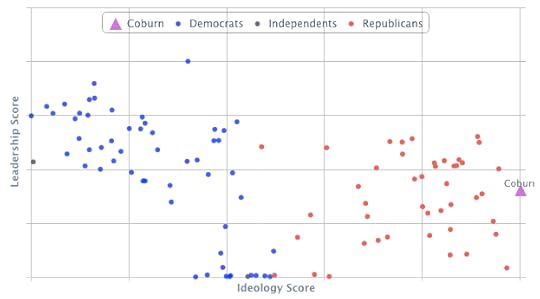
See: Tom Coburn | Mark Kirk | Joe Manchin | Pat Toomey
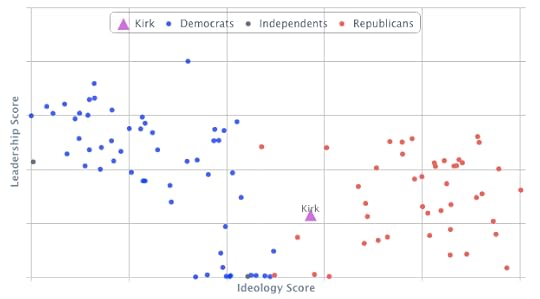
See: Tom Coburn | Mark Kirk | Joe Manchin | Pat Toomey
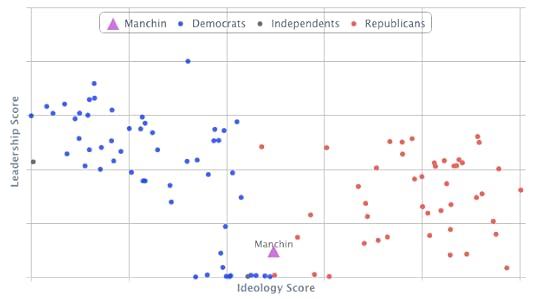
See: Tom Coburn | Mark Kirk | Joe Manchin | Pat Toomey
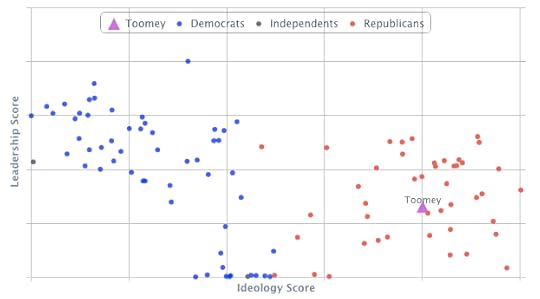
A number of the more conservative members of the Senate have joined Rand Paul in threatening a filibuster of any new rules. It's not clear that the Manchin-Toomey proposal will convince the needed five Republicans — much less the 55 Democrats and independents — that would be needed to break the filibuster. The key consideration is NRA-stoked concern that expanded background checks would lead to a national gun owner reigstry — despite such a thing being illegal under current law. (A recent poll suggests that the argument is also gaining ground with voters.) When the Post says the compromise "addresses concerns of some conservatives," it doesn't mean those who are concerned about such a registry. Toomey and Manchin have to pick up what few Republicans they can from the rest.
This is the remaining battle: the NRA versus the middle. Obama advisors can rail against filibuster threats, but — the bully pulpit of presidential speeches aside — Obama doesn't have much sway on Capitol Hill. The Times articulated his awkward position in an article this weekend.
Members of both parties say Mr. Obama faces a conundrum with his legislative approach to a deeply polarized Congress. In the past, when he has stayed aloof from legislative action, Republicans and others have accused him of a lack of leadership; when he has gotten involved, they have complained that they could not support any bill so closely identified with Mr. Obama without risking the contempt of conservative voters.
The NRA is in the opposite position. As the Post noted this weekend, the organization has seen as much in curtailing state regulations since Newtown as it has in controlling the Congressional debate. That article focuses on Democratic senator Mark Begich of Alaska. After Newtown, Begich claimed a "sea change" in attitudes on regulating weapons. Last month, he co-sponsored a bill with South Carolina's Lindsey Graham that expanded background checks — in precisely the limited way the NRA has advocated.
The Senate is expected to vote on the package of gun legislation next week. It remains to be seen what background check bill — if any — might be approved. After that, the package heads to the House. For those curious how it will fare there, consider this: the president and Democrats liked their chances of strong legislation much better in the Senate.









An Early Version of Facebook Home Is Out in the Wild
For those looking to get an early version of Facebook Home it's not worth downloading this leak that came out this morning, since its "rather buggy and incomplete," according to Paul O'Brien of MoDaCo who discovered the early release. While the software leak seems to work on more than just the select Android devices mentioned during the unveiling of Facebook's new smartphone, some of the most highly touted features, like the useful texting feature Chat Heads, do not function. Even so, this is the closest look that anyone has had at the software outside of Facebook's press event last Thursday
There are some details in the screen shots at MoDaCo which weren't mentioned last week, such these settings, which suggests that users have some control of what shows up on Home's home screen.

It looks like it works kind of like push notification settings, such that people who don't want certain things popping up can block those things. That "Pages" setting also suggests that posts from "Pages" —as in: brands—don't have to pop up in the constant feed of images populating the home screen. While Facebook CEO Mark Zuckerberg said Home won't have ads (yet), it's not clear that applies to a company's page that someone subscribes to. This indicates that it does not—a sneaky way for the network to squeeze in some ads. (Though, it should be noted: Facebook does not make money off of brand page posts, unless a company pays to promote them.)
In addition to these settings, it looks like home screen has automatic Instagram integration, too:

That bodes well for the quality of photos showing up as the background of our phones. At least in my experience, baby and partying pictures mostly relegate themselves to Facebook proper, whereas Instagram—maybe because of the filters?—has less people and more (sometimes pretty!) stuff.
For those who want to check out Home early, The Next Web has an easy tutorial for how to download this leak. But, given the functional limitations, it's probably worth waiting until Friday to get the full-blown, working version of the "apperating system."









Look What Plastic Surgery Has Done to HBO's Liberace Movie
After a few teasers there, HBO finally gave the world a full trailer for Steven Soderbergh's Behind the Candelabra last night, and while the Liberace biopic looks great (Michael Douglas has got that trademark nasal voice down pat), well, this thing is a cosmetic nightmare. Of course, that's a good thing for the life story of Liberace, a story that has so much to do with plastic surgery.
The most shocking face belongs to Rob Lowe, who is something of a wax figurine in real life and is rumored to have had a little work done. But he looks one step away from Michael Jackson in his role as Liberace's plastic surgeon:

Those eyebrows! That hairline! And of course his job in the film is to make Matt Damon, who plays Liberace's lover Scott Thorson, look like Liberace.
And then there's Liberace himself, played by Douglas, whom we even see being wheeled along with a face full of bandages:

The only actor in the film who seems immune to cosmetic enhancement is Debbie Reynolds, virtually unrecognizable—in a different way—as Liberace's mother.

May 26 cannot come soon enough. This is our kind of cautionary tale.









April 6, 2013
North Korea's Army Is Full of Jumping, Leaping, High-Kicking Martial Artists
Amid all of the very real threats of war and stuff from North Korea, you'd think American intelligence officers want as much video footage of the enemy as possible. Well, here is one video featuring North Korean exercises and Kim Jong-Un holding a gun, and we'll say this: they certainly get points for presentation.
Remember the clap-happy report from Dennis Rodman's diplomatic basketball vacation? This video comes courtesy of the same Youtube channel that gave us that Rodman video. It appears to be the same state news channel.
This latest dispatch from North Korea's state television features some kind of military demonstration put on for Kim Jong-Un, complete with a wonderful soundtrack. The leader surveyed his highly-trained, deadly team of martial artists and sharp shooters ahead of trying to provoke a response from either South Korea or the U.S. He even showed some of a group of his military commanders and advisers how to shoot a gun. And this, folks, is what we're up against. Let's take a closer look at what this video shows us.
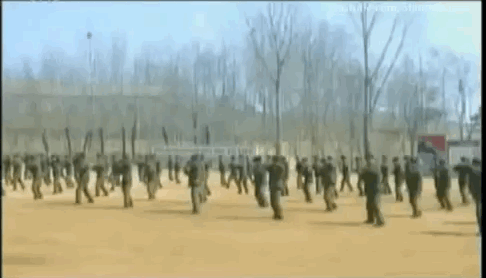
First, we get a glimpse of the very organized, in sync, North Korean military doing what appear to be dance steps. Their form is strong and they're clearly working as a unit. This looks like they've put in a lot of time at rehearsals, and it's paying off. They might make sectionals next year.
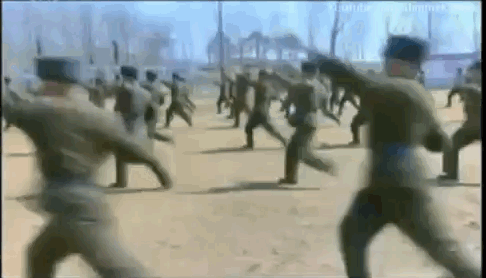
Here's a much closer look of their furious dance moves. Their high kicks and are impressively high, though that one guy needs to remember to keep his leg straight. Form is important, guys. The judges are watching. Their punches pack a lot of, well, punch, so they have that going for them. They have a lot of flair.
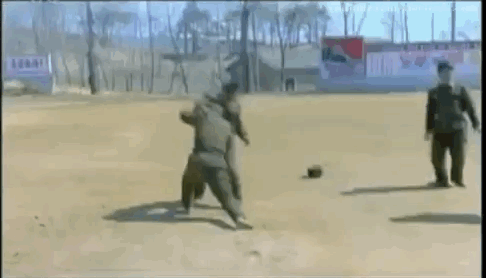
The North Korean military is also very excited for Wrestlemania this weekend. Here, we see four soldiers demonstrating their wrestling prowess. On the left, one soldier performs a fireman's carry suplex and appears to kill his victim. He then jumps backward and takes a "bump" himself for good measure. Maybe he was trying to do a "People's Elbow" like his idol and this weekend's headliner, The Rock. We have watched this GIF probably 50 times and cannot figure out why he jumps backwards. It will keep us up at night. Because it's hilarious. On the right, one soldier ducks a punch to perform a belly-to-back suplex. Any collegiate wrestler would tell you his form needs work, though. Ge gets an assisst from his dance partner jumping into it. It looks like the jumper lands on his head, which isn't safe, and would be called a "botch" if performed in the ring.
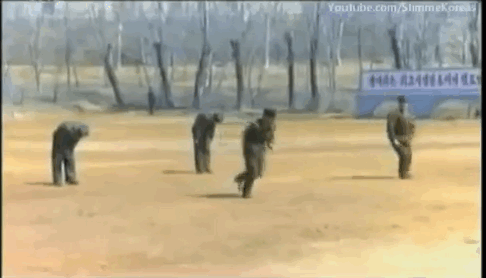
We cannot figure out a practical application for this flipping manoeuvre on the battlefield but it is undeniably fierce. That roll out is so smooth, so well executed. You can't hate on this.

"OK, this is the part where you play dead. Ready, set, go." They almost invoke memories of the putty patrol from Might Morphin' Power Rangers.

At this point the video gets kind of boring. Un goes to a shooting range with some guys in funny hats. He watches soldiers fire at long range targets and then goes to inspect the results. Unsurprisingly, they only hit the center of the target. We're all doomed, if you haven't figured that out already. For good measure, Un also inexplicably starts brandishing a handgun. It's a little worrisome, because he haphazardly points it in the direction of his friends a few times. Hopefully the safety is on. Because Un is the smartest, most badass and most dangerous man in every room, he decides to show his travelling party the proper way to point the gun at American scum. "This is how you kill the American scum dead," he's telling them in this GIF










Are Forbes Writers 'Dying Inside'?
The San Antonio Spurs' Stephen Jackson is one of the most overpaid players in the National Basketball Association, according to a man who Jackson says is "dying inside."
Forbes' Tom Van Riper released a list Friday morning chronicling who he figures are the most overpaid players in basketball. San Antonio pays Jackson $10 million a year, but he only averages about six points and three rebounds per game. (You may also know Jackson as the crazy man who went into the stands to attack fans during 2004's "Malice at the Palace.") This is not a good contract, according to Van Riper. It was enough to land Jackson the number nine spot, behind players like Dallas' Dirk Nowitzki and New York's Carmelo Anthony. Jackson was speaking with reporters Saturday morning when he was first told about his latest distinction.
"I been underpaid my whole career," Jackson said. "Whether they think that or not, still getting paid almost $10 million this year," he added, with a thumps up and a smile for the camera. A reporter told Jackson the list was being widely criticized by other sports writers.
"Who made the list?" Jackson inquired.
"Some business writer," the reporter answered.
"Someone dying inside, probably," Jackson said.
After the thumbs up and the zinger, we're about ready to call this mini-war of words in Jackson's favor. KO victory, first round. We reached out to Van Riper but he didn't get back to us on time.
If it wasn't already clear, Jackson is taking the slight in stride. He's already found the optimistic way to look at it. "Well, I'm happy to be on that list," he said. If Dirk Nowitzki and Carmelo Anthony are on that list, I'm doing a great job. My life is going in the right direction." You can watch all of Jackson's exchange with reporters -- there's a bit about Anchorman in there, weirdly -- right here.









The Rutgers Scandal Now Has an F.B.I. Extortion Investigation
If you had an extortion investigation in your "what twists the Rutgers basketball scandal will take next" pool, well, collect your winnings. Also, buy a lottery ticket because you may be telepathic. Because the F.B.I. is investigating Eric Murdock, the whistleblowing former assistant coach, for extortion.
University officials let it slip to The New York Times' Steve Eder that Federal Bureau of Investigation officers recently visited the campus and met with athletic director Tim Pernetti sometime before Pernetti was fired on Friday. They're trying to determine whether or not Murdock, the former director of player development, tried to extort the school before becoming the man who blew the lid off this whole scandal. Murdock leaked the video of now-former basketball coach Mike Rice physically assaulting and yelling at his players over the course of the first three years of his time as head coach to ESPN's Outside the Lines.
Murdock originally claimed to show Pernetti the video in June 2012, but that turend out to be false. He did raise the issue of Rice's behavior with Pernetti in June. But the athletic director didn't see the video of Rice until November and Murdock was the one who showed Pernetti the footage. Murdock and Rutgers parted ways shortly after. He claims it was over the whistle blowing.
 After witnessing Rice's actions firsthand via Murdock's video, the school commissioned an independent investigation led by New Jersey lawyer John P. Lacey as to how to proceed with Rice. The report didn't make any recommendations as to whether or not the school should fire the head coach, which the school finally did this week, but it did conclude that Rice violated school policy and his contract. That investigation also looked at whether or not Murdock's interpretation that he was fired for being a whistleblower was true. The investigation sided with Pernetti and Rutgers: Murdock's contract wasn't renewed for reasons beyond his whistle blowing.
After witnessing Rice's actions firsthand via Murdock's video, the school commissioned an independent investigation led by New Jersey lawyer John P. Lacey as to how to proceed with Rice. The report didn't make any recommendations as to whether or not the school should fire the head coach, which the school finally did this week, but it did conclude that Rice violated school policy and his contract. That investigation also looked at whether or not Murdock's interpretation that he was fired for being a whistleblower was true. The investigation sided with Pernetti and Rutgers: Murdock's contract wasn't renewed for reasons beyond his whistle blowing.
How does leaking a video and getting your old boss fired amount to extortion, you ask? Well, ESPN'S Don Van Natta Jr. reported Friday that Murdock wrote a letter to the school demanding $950,000 to settle his wrongful termination claims a month after he first showed Pernetti the video. Rutgers politely declined. Murdock filed a lawsuit against the school on Friday. So, uh.









What We Didn't Know About the Start of America's Drone War Killed Thousands
The details of the bloody back-room deal between Pakistani and American officials that led to the U.S. regularly carrying out unmanned strikes in Pakistan have been shrouded in secrecy, until now, and the reports of the first strike are strange to read now, in retrospect. But what does retrospect mean in America's drone war, anyway?
It was all the way back in June 2004, before Obama was elected, before he started to wind down the wars Iraq and Afghanistan, before people like Rand Paul started to ask a lot of questions. As detailed in The New York Times's Sunday front-page excerpt of Mike Mazzetti's new book, The Way of the Knife: The C.I.A., a Secret Army, and a War at the Ends of the Earth, out on Tuesday, the Central Intelligence Agency struck a deal with Pakistani officials to kill Nek Muhammad in exchange for the opportunities to carry out drone strikes on Pakistani soil. The agency assassinated a person to get the airspace to assassinate more people. The U.S. acted as a hired gun, so it could build up its "targeted killing" program. And then the U.S. covered up its first Predator strike in Pakistan, the first of many, many more in a new kind of secret war. "The C.I.A. has since conducted hundreds of drone strikes in Pakistan that have killed thousands of people, Pakistanis and Arabs, militants and civilians alike," Mazetti writes.
The 27-year-old Muhammad was an enemy of the state in Pakistan. He had organized a tribal rebellion against the government and gave them fits. His clashes with the Pakistani government had come to a tipping point, so then-C.I.A. director George Tenet approached Pakistan with a deal. The U.S. would kill Muhammad in exchange for access to Pakistan's airspace to carry out further drone strike. Mazzetti writes that Muhammad mentioned seeing a "strange, metallic bird hovering above him," during an interview on the day he died. It was the Predator that would eventually kill him — a weapon "cheered by Republicans and Democrats alike" at the time, a marvel of technological accomplishment — but it wasn't the Pakistani missile attack that was reported as the cause of Muhammad's death.
Part of the deal was that Pakistan would take credit for any and all American drone strikes on its territory. The country didn't want to give critics the appearance of looking like it was under Washington's thumb. This is how the Times reported the drone accusations at the time of Muhammad's death in 2004:
Local residents said they believed that a missile fired from an American drone killed the militant, Nek Muhammad, after he spoke over a satellite phone. But Pakistani military officials denied any American involvement.
The chief spokesman for the Pakistani military, Maj. Gen. Shaukat Sultan, said any suspicion of American involvement in Muhammad's death was "absolutely absurd." Pakistan still doesn't confirm American drone activity on record; officials sometimes do when granted anonymity. But the debate over "targeted killing" has evolved in the years since the deal was struck, and was evolving before the U.S. ever sent one of its metallic birds to Pakistan. The U.S. was operating and carrying out morally questionable drone strikes in Yemen starting in 2002. Pakistan was originally a huge fan of the idea, thinking they'd never get caught. Now the country resents America, but the government occasionally uses the U.S. to cover up its own drone strikes. The U.S. is Pakistan's occasional drone scape goat so they won't face criticism from their own civilians.
Meanwhile, the U.S. moved on elsewhere, including to Saudi Arabia, in another drone-airspace deal we didn't find out about until recently, until white papers leaked and Senators started asking more drone questions than ever around the confirmation of John Brennan, the architect of the drone program, to head up the C.I.A. In the midst of that debate, the President made promises to be more transparent about the drone activities during his new term. From the State of the Union:
"So in the months ahead, I will continue to engage Congress to ensure not only that our targeting, detention and prosecution of terrorists remains consistent with our laws and system of checks and balances, but that our efforts are even more transparent to the American people and to the world."
So that means secret deals for drone strike airspace will be reported earlier, as in, not almost a decade later, and after the CIA is officially out of the drone business, right? Don't hold your breath, but there's still a lot of explaining to be done.









Atlantic Monthly Contributors's Blog
- Atlantic Monthly Contributors's profile
- 1 follower



